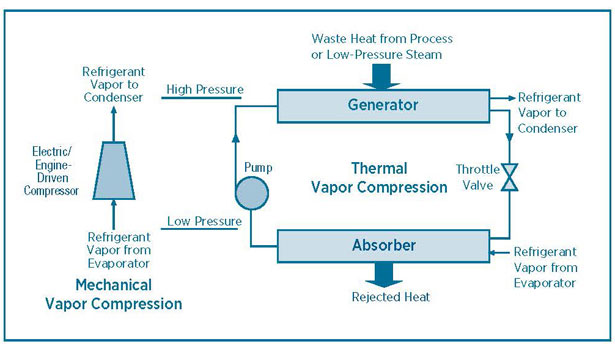Absorption chillers use heat, instead of mechanical energy, to provide cooling. The mechanical vapor compressor is replaced by a thermal compressor (see figure) that consists of an absorber, a generator, a pump, and a throttling device. The refrigerant vapor from the evaporator is absorbed by a solution mixture in the absorber. This solution is then pumped to the generator where the refrigerant is revaporized using a waste steam heat source. The refrigerant-depleted solution is then returned to the absorber via a throttling device. The two most common refrigerant/absorbent mixtures used in absorption chillers are water/lithium bromide and ammonia/water.
Compared to mechanical chillers, absorption chillers have a low coefficient of performance (COP = chiller load/heat input). Nonetheless, they can substantially reduce operating costs because they are energized by low-grade waste heat, while vapor compression chillers must be motor- or engine-driven.
Low-pressure, steam-driven absorption chillers are available in capacities ranging from 100 to 1,500 tons. Absorption chillers come in two commercially available designs: single-effect and double-effect. Single-effect machines provide a thermal COP of 0.7 and require about 18 pounds of 15-pounds-per-square-inch-gauge (psig) steam per ton-hour of cooling. Double-effect machines are about 40 percent more efficient, but require a higher grade of thermal input, using about 10 pounds of 100- to 150-psig steam per ton-hour.
Example
In a plant where low-pressure steam is currently being exhausted to the atmosphere, a mechanical chiller with a COP of 4.0 is used 4,000 hours per year (hr/yr) to produce an average of 300 tons of refrigeration. The cost of electricity at the plant is $0.06 per kilowatt-hour (kWh).
An absorption unit requiring 5,400 pounds per hour of 15-psig steam could replace the mechanical chiller, providing annual electrical cost savings of:
Annual Savings = 300 tons x (12,000 Btu/ton / 4.0) x 4,000 hr/yr x $0.06/kWh / 3,413 Btu
Annual Savings = $63,287
(Adapted from an Energy TIPS fact sheet that was originally published by the Industrial Energy Extension Service of Georgia Tech.)
Suggested Actions
Determine the cost-effectiveness of displacing a portion of a facility’s cooling load with a waste-steam absorption chiller by taking the following steps:
• Conduct a plant survey to identify sources and availability of waste steam.
• Determine cooling load requirements and the cost of meeting those requirements with existing mechanical chillers or new installations.
• Obtain installed cost quotes for a waste-steam absorption chiller.
• Conduct a life-cycle cost analysis to determine if the waste-steam absorption chiller meets the company’s cost-effectiveness criteria.
Reprinted from the U.S. Department of Energy, Office of Energy Efficiency & Renewable Energy, Steam Tip Sheet #14.
Publication date: 5/4/2015
Want more HVAC industry news and information? Join The NEWS on Facebook, Twitter, and LinkedIn today!


Report Abusive Comment